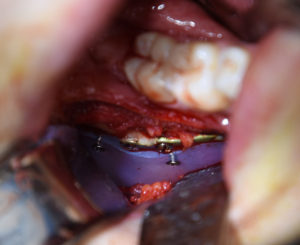The sagittal split osteotomy of the lower jaw is a well known orthographic surgery operation. Splitting the ramus of the mandible into two sagittal half allows the lower teeth that lies within the distal bone segment to be repositioned while maintaining maximal bone contact with the proximal bone segment. The split mandibular ramus goes on to heal after surgery because of this amount of bone contact
While the osteotomy site of the sagittal split mandibular osteotomy almost always heal uneventfully, there are bony shape changes that can occur. Changes in the shape of the jaw angle are not uncommon after this procedure due to an actual shift of the angle’s position or some resorption of the bone. As a result, while a patient’s bite may become perfect, a few patients will develop a malformed or jaw angle shape deficiency after surgery.
Jaw angle implants are a means to recreate jaw angle shape after these type of mandibular osteotomies. If a standard type of jaw angle implant is to be used the vertical lengthening style is the shape of choice. But many such jaw angle deformities, because of symmetry and differences in bony shapes, require a custom jaw angle implant approach achieve better jaw angle restoration symmetry.

The jaw angle implant is always secured into position with screws placed through its superior edge often done using a percutaneous technique.
Dr. Barry Eppley
Indianapolis, Indiana


